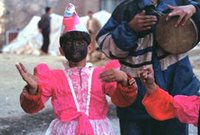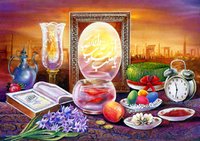
The primary religion in Iran today is the Shia sect of Islam but the far older faith of the prophet Zoroaster is still openly practiced, particularly in the central and northwestern regions of the country. The name of the founding Prophet of
Zoroastrianism is not Zoroaster, which is a Greek transliteration of the name, but Zarathushtra, which means, in ancient Iranian, "yellow camel."(zara = yellow, ushtra = camel). An alternate reading is "old camel." Animals such as camels and horses were essential and even sacred to the people of Zarathushtra's age, and thus a name containing one of these animals marks a person as important. A similar naming practice occurred among the ancient Greeks where names containing "-ippos" or horse denoted high birth - such as
Philippos(lover of horses),
Aristippos (best horse), or
Xanthippos(yellow horse).
The later Zoroastrians said that the name meant "Golden Light," deriving their meaning from the word zara and the word ushas, light or dawn. There is no doubt about Zarathushtra's clan name, which is Spitama - perhaps meaning "white."Zarathushtra's father was named
Pouruchaspa (many horses) and his mother was named
Dughdova (milkmaid). His birthday is celebrated on March 26, as part of the Iranian
New Year Festival.
No one knows where or when the Prophet was born. Some legends place his birth in western Iran; others, place his birthplace in the east. As for the date of his birth, it has been since ancient times a matter of controversy. The traditional Zoroastrian date for Zarathushtra's birth and ministry is around 600 B.C. This is derived from a Greek source that places him
"300 years before Alexander" which would give that date; other rationales for the 600 BC date identify the
King Vishtaspa of Zarathushtra's
Gathas with the father of the Persian King
Darius, who lived around that time.
As the linguists of both Europe and India worked on the Gathas, however, it became clear that the language of the Gathas attributed to Zarathushtra was far older than the language spoken in Iran at the time of King Darius' father.
Gathic Avestan was very close to the
Sanskrit of the Indian Rig-Vedas, which can be dated from the period 1500-1200 BC. Recent work by Martin Schwartz and Almut Hintze tends to discount this theory, as the linguists show that the
Gathas are not the work of an academic writing in a dead language; they show all the signs of poetry composed and recited in an oral tradition, similar to the heroic poetry of
Homer or the
Rig-Vedas.
Zarathushtra received his prophetic calling in about his thirtieth year, in which he envisioned God through
Vohu Manah, or
"Good Mind." His prophecies were not foretellings of the future, but prophecy in the sense of the later Hebrew prophets: revolutionary messages of religious purity and social justice, speaking out against corrupt priests and potentates. There is very little biographical material in the Gathas. What is there indicates that Zarathushtra was cast out of his original home, wherever that was, and forced to wander, along with his followers and their animals. Yasna 46 begins with a sad verse about this:
"To what land should I turn? Where should I turn to go?
They hold me back from folk and friends.
Neither the community I follow pleases me,
nor do the wrongful rulers of the land...
I know... that I am powerless.
I have a few cattle and also a few men."He and his followers wandered until they found a sympathetic friend in
King Vishtaspa, who was not the father of King Darius but an earlier ruler of the same name, who may have lived in eastern Persia or in
Bactria, modern Afghanistan. There, Zarathushtra won over the king, and his court, and became the court prophet.
Zarathushtra is said to have had six children, three boys and three girls. This is not exact information, since the number and gender equals that of the
six Amesha Spentas and may be only symbolic. But the last Gatha is composed for the marriage of Zarathushtra's daughter
Pouruchista (Full of Wisdom) so he is known to have had at least one child. Zarathushtra, in the legends, had three wives of whom the last was
Hvovi the daughter of King
Vishtaspa's prime minister. There is no exact or provable information about Zarathushtra's life at court, though it may be assumed that it was here that he composed the Gathas, and the names of king and court appear in the poetry as if, in oral recitation, they were there listening to him. The prophet may have spent almost three decades there, before his death at age 77.
Again, no one knows how Zarathushtra died. Many legends, and Zoroastrian tradition, say that he was killed, while praying in the sanctuary, by a foreign enemy of the king. But there is no holiday commemorating the martyrdom of the Prophet, as there would be in other religions
(Christianity, for instance) and other Zoroastrian traditions, and scholars, say that Zarathushtra died peacefully.
In the later
Avesta, Zarathushtra is used as a character in dialogue with
Ahura Mazda; he is featured in ritual texts and in law- texts, and great amounts of ritual and doctrine are thus attributed to him, whether he was their originator or not. In much later Zoroastrian traditions, some of which were not recorded until centuries after the Arab conquest, the life of the Prophet abounds with miracles and divine interventions.
The Legend of Zoroaster:His mother glowed with the divine Glory usually reserved for kings; the soul of the prophet was placed by God in the sacred Haoma plant (which Z. condemned in the Gathas)and the prophet was conceived through the essence of Haoma in milk (though the birth is not a virgin birth, but the natural product of two special, but earthly parents.). The child laughed at his birth instead of crying, and he glowed so brightly that the villagers around him were frightened and tried to destroy him. All attempts to destroy young Zarathushtra failed; fire would not burn him nor would animals crush him in stampedes; he was cared for by a mother wolf in the wilderness.
He spent years in the wilderness communing with God before his first vision, in which Vohu Manah came to him in the form of a huge Angel. All the heavenly entities, the Amesha Spentas, instructed Zarathushtra in heaven, and he received perfect knowledge of past, present, and future. Zarathushtra's preaching to King Vishtaspa was enhanced by miracles, especially the healing of a paralyzed horse that convinced the king to accept the new religion. Most of these motifs are familiar from the lives of other culture heroes such as
Romulus,
Moses, and
Jesus. Whether any of this literally happened is a matter for belief, not scholarship. Tradition-minded Zoroastrians do accept these legends as truth about Zarathushtra. Other, more modern Zoroastrians, who rely more on the Gathas as a scriptural source, discount the legends as pious fantasies, noting that there are no miracles or supernatural interventions in the Gathas.
Ever since ancient Greek times the name of Zoroaster has stood for mysterious Eastern wisdom. In
Hellenistic times many esoteric and magical texts were written using his name
(though none of those texts had anything to do with the real Zarathushtra) and Zoroaster was thought of as one of the greatest magicians. Once the
Avesta had been brought to the West in the 18th century, his name again became famous in the West - this time not for magic, but for the humanistic, monotheistic, moral philosophy found in the Gathas. Enlightenment philosophers such as
Kant and
Diderot mentioned him as a model; the playwright
Voltaire wrote a play called
"Zoroastre." Here was a philosopher from
"pagan" antiquity who was monotheistic and moral without any help from the Christian Church! The French composer
Rameau wrote an opera called
"Zoroastre" and the free-thinking
Mozart used a variant of the name for his character
Sarastro in
"The Magic Flute;" Sarastro is the priest of the Sun and Light who defeats the Queen of the Night. In the 20th century
Nietszche was inspired by Zarathushtra's example when expounding his philosophy in THUS SPAKE ZARATHUSHTRA, though there is no identifiable Zoroastrian teaching in the Nietszche work. The German composer
Richard Strauss, inspired by the Nietzsche work, wrote the tone-poem of the same name, which became famous in the 1960s as the theme for the
Stanley Kubrick film 2001 -
A SPACE ODYSSEY. Zarathushtra was never divine, not even in the most extravagant legends. He remained a man like all others, though divinely gifted with inspiration and closeness to
Ahura Mazda. His life is an inspiration for Zoroastrians of all persuasions, traditionalist and modern - in his innovation, loving relationship with God, and spiritual courage he is a model for all his followers. After his death. Zarathushtra's great soul attains almost the level of a Bounteous Immortal, but still is not merged in the divinity.
Today there are still a number of fire temples around the world that burn in the memory of Zoroaster. One of the most famous ones is the temple of
Chak Chak near
Yazd in Iran
( i will elaburate on the theme of temples in the near future).Pictures of Zoroaster:http://www.zarathushtra.com/z/life/images/zpic12.jpghttp://www.zarathushtra.com/z/life/images/z9-full.jpghttp://www.zarathushtra.com/z/life/images/z10oldbw.jpghttp://www.zarathushtra.com/z/life/images/z4.gifTo read Gatha in English visit:http://www.zoroaster.com/gatha.htmTo read Avesta in English visit:http://www.zoroaster.com/avesta/avesta.htmPicture of the Temple of Chak Chak near Yazd-Iran:http://www.sacredsites.com/december2001photos/420.jpgPicture of Temple of Pir-e-Naraki near Yazd:http://www.sacredsites.com/december2001photos/503.jpg


